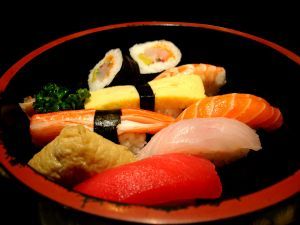If you aren’t sure what sushi is, be sure to read my article on my AC profile entitled What is Sushi? for more information. This article will give you a basic overview of what sushi is, its origins, and some information about the health benefits of sushi too. You will also learn the difference between sushi and sashimi, since many Americans believe sushi is raw fish, and it is not. Raw fish or cured fish is sashimi, and while sushi may contain sashimi, it is not necessary.
I have loved sushi since the very first time I tried it about 10 years ago. Today, I can’t get enough of it, though it is very expensive here in America, and it is difficult to find fresh sushi that is properly prepared. Old sushi, packaged sushi at the stores, will not have the same taste as freshly prepared sushi. I think this is why many people are turned off to sushi before even trying it.
Sushi contains kelp or seaweed, and when kelp is fresh and not dried or processed, it has a taste very similar to fresh spinach, but when it is dried or processed or when it is old, it will have a bit of a fishy smell to it and will taste a bit like dirt. Therefore, fresh kelp is essential for good sushi.
When you purchase sushi at a grocery store, chances are you will buy sushi with dried or processed kelp and not the fresh variety. Most restaurants that serve sushi will serve fresh kelp, and not the dried variety, and you can usually find fresh kelp in a small Asian market or in the Asian section of your grocery store. If you cannot find fresh kelp, the dried but non-processed kelp is your best second choice, but be sure to follow the instructions for properly re-hydrating the kelp prior to using it.
In my opinion, the single most important part of great tasting sushi is using fresh kelp, and the second most important part would be selecting the ingredients to include in the sushi roll. The most popular ingredients for a sushi roll is fish or seafood. However, if you are a beginner sushi taster, you might prefer to start with a California roll sushi instead.
California roll sushi was invented in the 70s in order to allow Americans, who seemed to have a distaste for what appeared to be raw fish, to sample sushi without raw fish. California roll includes avocado, cucumber, real or imitation crab meat (cooked), and then the traditional sweet rice and kelp wrap.
If seafood isn’t your style, there are many vegetarian version of sushi too, and if you are ordering in a restaurant, you can simply ask your waiter or waitress which version of sushi are vegetarian. Most vegetarian versions of sushi contain celery, cucumber, carrot shreds, and some contain pickles.
If you love seafood, and have tried the odd types of seafood outside of eating sushi, then you will likely enjoy sushi itself. Most sushi that uses fish will use saltwater fish. In America, there are very few restaurants with licensed sushi chefs allowed to serve real raw fish, such as is served in Japan or China, so chances are if you order sushi in an American restaurant, you will receive cured or steamed fish. However, some restaurants do indeed serve the real raw versions, so if you are unsure, you may want to ask your wait staff.
As a general rule, saltwater fish do not contain parasites of any kind, unlike the freshwater fish varieties. However, salmon has been known to occasionally have problems, yet in America, salmon is one of the most popular fish items for sushi, caviar, and other seafood delicacies. Personally, I’m a bit leery of salmon that is not properly cooked, but I will eat any other variety of raw and fresh seafood offered on sushi menus. Additionally, I’ve found salmon to be the most ‘fishy’ smelling and tasting of all sushi varieties too.
When you are ready to venture past the California roll sushi, your next step into sushi sampling might be the tuna sushi. The reason this is a good choice is because most people are familiar with tuna and are used to eating tuna in cold form, such as tuna salad and tuna out of a can, instead of eating hot tuna fillets (although they do serve great tuna fillets at one restaurant here in town, yummy). Taking the plunge from cold tuna to fresh tuna in a sushi roll is not quite as big a leap as sampling raw mackerel when you’re used to eating baked or fried fish.
There are several varieties of tuna to sample too. Some of the names you might find at a restaurant for tuna sushi are: maguro (tuna), toro (fatty tuna underbelly), shiro maguro (albacore tuna). Of course, there is yellowtail (hamachi), but this is a bit gamier type of tuna for a beginner. Remember these words or take a cheat sheet with you to the restaurant just in case the menu doesn’t explain what the words mean, and you will be ready to order tuna sushi like a pro.
If you have eaten seafood before, such as shrimp, crab or scallops, then choosing a sushi with shrimp and/or scallops and/or crab is a good choice too. If you look for scallop sushi on the menu, the words you might look for are kobashira (small scallops) and kaibashira (large scallops). I love scallops and I love sushi, so scallop sushi is a great choice for me.
I also love shrimp, and shrimp sushi is usually served with a large butterflied shrimp over a roll of rice (nigiri sushi, fish on rice), but it can be served with small pieces rolled into the sushi roll too.
When you become acclimated to eating cold or raw fish, you can then move up into the more daring sushi choices such as mackerel, clam, or my personal favorite – smoked eel. I know it sounds nasty to most Americans, but if you’ve never tried smoked eel, or smoked eel sushi, you simply don’t know what you are missing!
Now, if you cannot bring yourself to stomach raw or even cooked but cold fish, there are some Americanized varieties of sushi to consider as a beginner that might suit you nicely and allow you to experience some of the sushi culture:
California roll: cucumber, crab, avocado
Boston roll: scallion, crab and salmon (all cooked)
Philadelphia roll: cream cheese, smoked salmon and cucumber
Texas roll: beef and cucumber
When you keep in mind that sushi really refers to the rice mixture and not raw fish, then sushi can literally be prepared with just about anything you’d like. If you find a restaurant that has a fresh sushi bar, you can have your sushi made to order out of all the different choices available to you.
Lastly, many sushi bars are aware that not all Americans have tried sushi before, so if you ask, the sushi chef may allow you to sample some of the sashimi or even the sushi at no cost. If you are thinking about venturing out and trying sushi at a local restaurant, be sure to look for my next article on Sushi Eating Etiquette, which can be found on my Associated Content profile, so that you know the right way to eat sushi in public. Enjoy!







